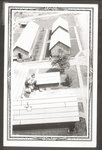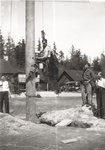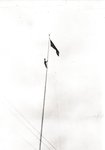


The Civilian Conservation Corps, which put young men to work building parks facilities and other public projects during the Great Depression, left an impression on the head of one young man and in the memory of another.
Frank Ward was with the Civilian Conservation Corps Company 1633 at Rainbow Falls State Park in west Lewis County in 1935.
The company had received a great deal of publicity for having the tallest unguyed, single pole in any CCC Camp. Theirs was 125 feet above ground level.
When work at Rainbow Falls was completed, the flag pole was left behind. Then, in about 1934, another camp erected a pole that was 130 feet high.
Company 1633, now at Lewis and Clark State Park, were determined to regain the honor of having the tallest flag pole. They found a tree that, when raised, was measured at 135 feet above ground.
On June 1, 1935, several enrollees were involved in a fracas which resulted in their discharge. After they were put on a train for home it was discovered that the halyard had been cut and lay at the bottom of the pole on the very day it was to be dedicated — dignitaries and all.
The immediate problem was how to get the halyard rethreaded through the pulley at the top of the pole.
An enrollee who had some experience climbing volunteered to climb the pole and replace the rope. After being rigged the young man undertook climbing the pole but when about 60 feet up and tired he stopped to rest.
Looking down, he froze. Unable to move, no amount of persuasion could get him to go up or down.
Frank Ward, a “sky line” rigger in the big timber, was prevailed upon to climb up and get the enrollee down.
He was unable to induce the lad to descend, not even when Frank rigged a block and a “bosin” chair in which to let him down.
Finally Frank had to climb past the man, but as his feet were about level with his head, he planted a swift kick and knocked the fellow out. Then Frank rapidly loosened the gear and, with the assistance of a ground crew, lowered the man to the ground before most viewers realized what had happened.
Frank then went up again, threaded the halyard through the pulley at the top of the pole and returned to the ground.
Without Frank, the dedication would have been a flop, according to an article in the NCACCCA newsletter of August 1987 about this August 1934 event.